2020最新中考英语必考知识点大全
- 格式:doc
- 大小:284.00 KB
- 文档页数:113
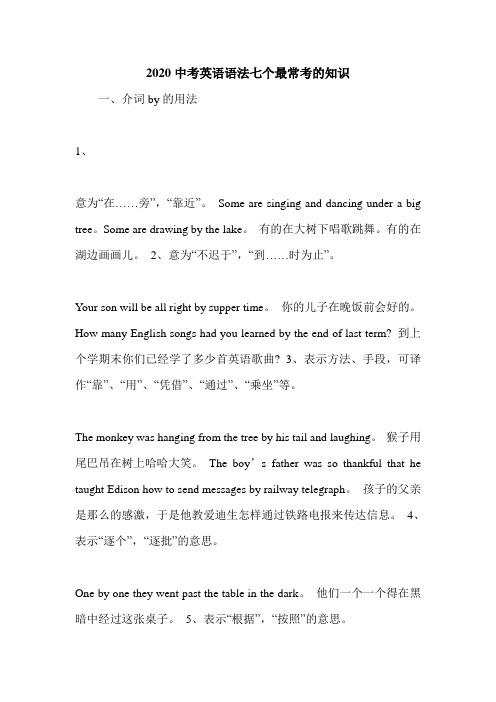
2020中考英语语法七个最常考的知识一、介词by的用法1、意为“在……旁”,“靠近”。
Some are singing and dancing under a big tree。
Some are drawing by the lake。
有的在大树下唱歌跳舞。
有的在湖边画画儿。
2、意为“不迟于”,“到……时为止”。
Your son will be all right by supper time。
你的儿子在晚饭前会好的。
How many English songs had you learned by the end of last term? 到上个学期末你们已经学了多少首英语歌曲? 3、表示方法、手段,可译作“靠”、“用”、“凭借”、“通过”、“乘坐”等。
The monkey was hanging from the tree by his tail and laughing。
猴子用尾巴吊在树上哈哈大笑。
The boy’s father was so thankful that he taught Edison how to send messages by railway telegraph。
孩子的父亲是那么的感激,于是他教爱迪生怎样通过铁路电报来传达信息。
4、表示“逐个”,“逐批”的意思。
One by one they went past the table in the dark。
他们一个一个得在黑暗中经过这张桌子。
5、表示“根据”,“按照”的意思。
What time is it by your watch? 你的表几点了? 6、和take,hold等动词连用,说明接触身体的某一部分。
I took him by the hand。
我拉住了他的手。
7、用于被动句中,表示行为主体,常译作“被”、“由”等。
English is spoken by many people。
英语被许多人说。
(即“许多人讲英语。
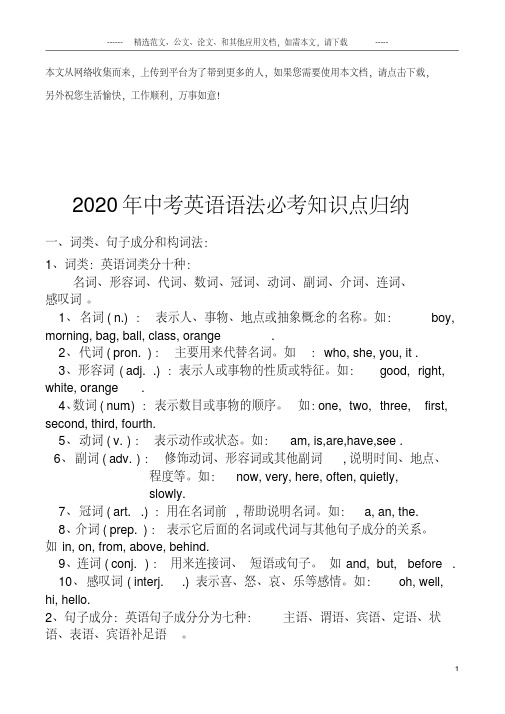
本文从网络收集而来,上传到平台为了帮到更多的人,如果您需要使用本文档,请点击下载,另外祝您生活愉快,工作顺利,万事如意!2020年中考英语语法必考知识点归纳一、词类、句子成分和构词法:1、词类:英语词类分十种:名词、形容词、代词、数词、冠词、动词、副词、介词、连词、感叹词。
1、名词(n.):表示人、事物、地点或抽象概念的名称。
如:boy, morning, bag, ball, class, orange.2、代词(pron.):主要用来代替名词。
如:who, she, you, it .3、形容词(adj..):表示人或事物的性质或特征。
如:good, right, white, orange .4、数词(num.):表示数目或事物的顺序。
如:one, two, three, first, second, third, fourth.5、动词(v.):表示动作或状态。
如:am, is,are,have,see .6、副词(adv.):修饰动词、形容词或其他副词,说明时间、地点、程度等。
如:now, very, here, often, quietly,slowly.7、冠词(art..):用在名词前,帮助说明名词。
如:a, an, the.8、介词(prep.):表示它后面的名词或代词与其他句子成分的关系。
如in, on, from, above, behind.9、连词(conj.):用来连接词、短语或句子。
如and, but, before .10、感叹词(interj..)表示喜、怒、哀、乐等感情。
如:oh, well, hi, hello.2、句子成分:英语句子成分分为七种:主语、谓语、宾语、定语、状语、表语、宾语补足语。
1、主语是句子所要说的人或事物,回答是“谁”或者“什么”。
通常用名词或代词担任。
如:I’m Miss Green.(我是格林小姐) 2、谓语动词说明主语的动作或状态,回答“做(什么)”。

2020 中考英语语法七个最常考的知识一、介词 by 的用法1、意为“在旁”,“凑近”。
Some are singing and dancing under a bigtree。
Some are drawing by the lake。
有的在大树下唱歌跳舞。
有的在湖畔画画儿。
2、意为“不迟于”,“到时为止”。
Your son will be all right by supper time。
你的儿子在晚餐前会好的。
How many English songs had you learned by the end of last term? 到上个学期末你们已经学了多少首英语歌曲? 3、表示方法、手段,可译作“靠”、“用”、“依靠”、“经过”、“乘坐”等。
The monkey was hanging from the tree by his tail and laughing。
猴子用尾巴吊在树上哈哈大笑。
The boy’s father was so thankful that he taught Edison how to send messages by railway telegraph。
孩子的父亲是那么的感谢,于是他教爱迪生如何经过铁路电报来传达信息。
4、表示“逐一”,“逐批”的意思。
One by one they went past the table in the dark。
他们一个一个得在黑暗中经过这张桌子。
5、表示“依据”,“依据”的意思。
What time is it by your watch? 你的表几点了 ? 6、和 take, hold 等动词连用,说明接触身体的某一部分。
I took him by the hand。
我拉住了他的手。
7、用于被动句中,表示行为主体,常译作“被”、“由”等。
English is spoken by many people。
英语被很多人说。
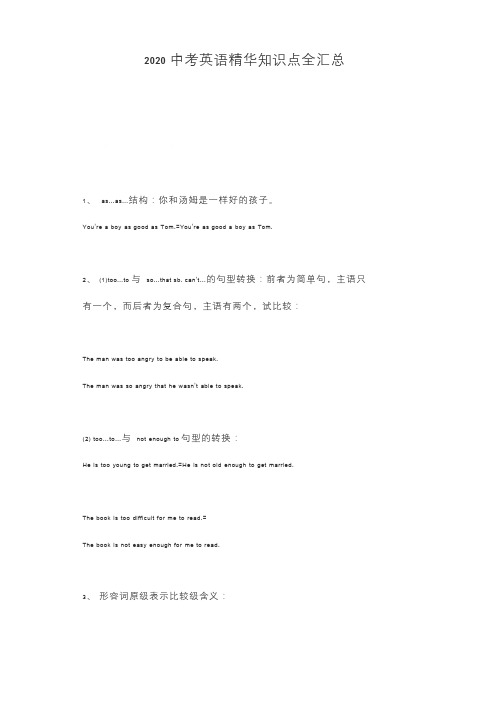
2020中考英语精华知识点全汇总1、as…as…结构:你和汤姆是一样好的孩子。
You’re a boy as good as Tom.=You’re as good a boy as Tom.2、(1)too…to与so…that sb. can’t…的句型转换:前者为简单句,主语只有一个,而后者为复合句,主语有两个,试比较:The man was too angry to be able to speak.The man was so angry that he wasn’t able to speak.(2) too…to…与not enough to 句型的转换:He is too young to get married.=He is not old enough to get married.The book is too difficult for me to read.=The book is not easy enough for me to read.3、形容词原级表示比较级含义:约翰不象迈克那么苯。
John is not so stupid as Mike.John is less stupid than Mike.John is cleverer than Mike.4、用比较级表示最高级:约翰是班里最高的男生。
John is taller than any other boy in the class.John is the tallest boy in the class.5、the more….. the more….表示“越……越……”:The more books you read, the wider your knowledge is.The more food you eat, the fatter you are.6、more and more….表示“越来……越……”:More and more students realized the importance of a foreign language. Our country is getting stronger and stronger.1. after, in 这两个介词都可以表示“……(时间)以后”的意思after 以过去为起点,表示过去一段时间之后,常用于过去时态的句子中?如:She went after three days. 她是三天以后走的in 以现在为起点,表将来一段时间以后,常用于将来时态的句子中如:She will go in three days. 她三天以后要走2. how long, how often, how soonhow long 指多长时间,主要用来对一段时间(如three days, four weeks 等)提问?如:How long ago was it? 这是多久前的事了?how often 指每隔多久,主要用来对频率副词或状语(如once a week 等)提问?如:—How often does he come here? —Once a month. 他(每隔)多久来一次?每月一次。
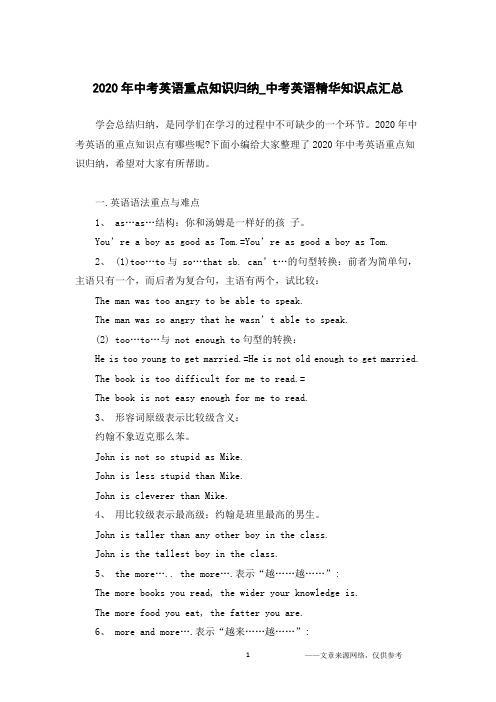
2020年中考英语重点知识归纳_中考英语精华知识点汇总学会总结归纳,是同学们在学习的过程中不可缺少的一个环节。
2020年中考英语的重点知识点有哪些呢?下面小编给大家整理了2020年中考英语重点知识归纳,希望对大家有所帮助。
一.英语语法重点与难点1、 as…as…结构:你和汤姆是一样好的孩子。
You’re a boy as good as Tom.=You’re as good a boy as Tom.2、 (1)too…to与 so…that sb. can’t…的句型转换:前者为简单句,主语只有一个,而后者为复合句,主语有两个,试比较:The man was too angry to be able to speak.The man was so angry that he wasn’t able to speak.(2) too…to…与 not enough to句型的转换:He is too young to get married.=He is not old enough to get married.The book is too difficult for me to read.=The book is not easy enough for me to read.3、形容词原级表示比较级含义:约翰不象迈克那么苯。
John is not so stupid as Mike.John is less stupid than Mike.John is cleverer than Mike.4、用比较级表示最高级:约翰是班里最高的男生。
John is taller than any other boy in the class.John is the tallest boy in the class.5、 the more….. the more….表示“越……越……”:The more books you read, the wider your knowledge is.The more food you eat, the fatter you are.6、 more and more….表示“越来……越……”:More and more students realized the importance of a foreign language.Our country is getting stronger and stronger.二.中考考点—词组1. after, in这两个介词都可以表示“……(时间)以后”的意思after 以过去为起点,表示过去一段时间之后,常用于过去时态的句子中?如:She went after three days. 她是三天以后走的in 以现在为起点,表将来一段时间以后,常用于将来时态的句子中如:She will go in three days. 她三天以后要走2. how long, how often, how soonhow long指多长时间,主要用来对一段时间(如three days, four weeks 等)提问?如:How long ago was it? 这是多久前的事了?how often指每隔多久,主要用来对频率副词或状语(如once a week等)提问?如:—How often does he come here? —Once a month. 他(每隔)多久来一次?每月一次。
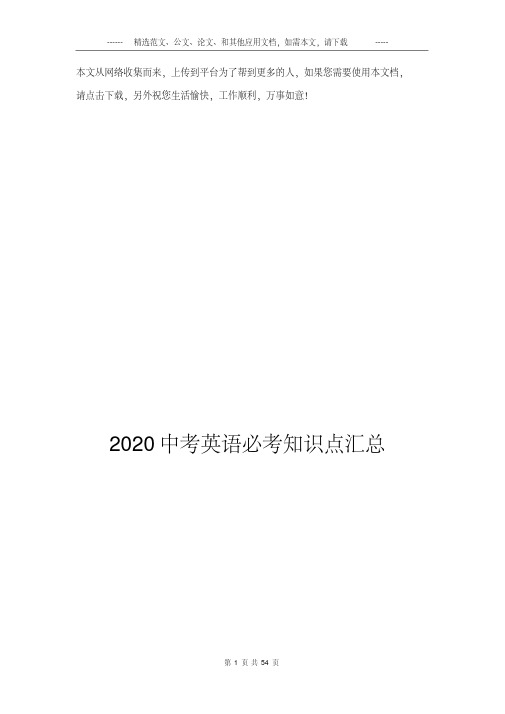
本文从网络收集而来,上传到平台为了帮到更多的人,如果您需要使用本文档,请点击下载,另外祝您生活愉快,工作顺利,万事如意!2020中考英语必考知识点汇总第一课时名词一、概述1、名词的属性:表示人或事物的名称抽象概念的词叫名词。
2、名词分普通名词和专有名词。
普通名词是表示某一类人或事物,或某种物体或抽象概念的名称。
如:teacher, desks, plates, milk, box 等,专有名词表示某一特定的人、事物、地方团体、党派、国家机关、语言、节日等专用的名称。
(运用)如:China, Chinese, Saturday, June, Green, Beijing, Olympic 等。
(专有名词的第一个字母要大写)二、可数名词与不可数名词1、可数名词是指表示人或事物,可以用数来计量的名词,有单复数之分。
如:glass-----glasses; book---- books2、不可数名词是指所表示的事物不能用数来计量。
如:paper, rice, water , milk, tea 等。
3、有些名词在特定情况下由不可数变为可数名词。
Light travels faster than sound; (light :光线,不可数)The lights are on. (light :灯,可数)4、不可数名词的量的表示不可数名词一般无法用数来计算,前面不能用a 或an 或数词来表示数量,它的量往往借助于容器来表示。
如:a glass of milk ------ four glasses of milka piece of paper ------ two pieces of papera bag of rice ------ three bags of rice三、可数名词的复数形式(识记、运用)1、可数名词在应用时有单复数之分,单数变复数有规则变化和不规则变化两种。
规则变化情况变化形式例词一般情况加-s girls; books; 以s,x,ch,sh 结尾的名词加-es classes; boxes; watches;brushes 以辅音字母加y 结尾的名词变y 为i, 加es city---cities; baby---babies 以f 或fe 结尾的名词变f,fe 为v, 加es knife---knives; leaf---leaves 以O 结尾的名词potatoes; tomatoes ;photos; kilos; bamboos; radios2、少数名词有不规则的变化形式policeman---policemen; man---men; woman---women;tooth---teeth; foot---feet; sheep---sheep; deer---deer;Japanese--- Japanese; Chinese --- Chinese; fish --- fish四、名词所有格(运用)名词的所有格是表示所有关系的形式,它也有构成上的变化。
一.英语语法重点与难点1、as…as…结构:你和汤姆是一样好的孩子。
You’re a boy as good as Tom.=You’re as good a boy as Tom.2、(1)too…to与so…that sb. can’t…的句型转换:前者为简单句,主语只有一个,而后者为复合句,主语有两个,试比较:The man was too angry to be able to speak.The man was so angry that he wasn’t able to speak.(2) too…to…与not enough to句型的转换:He is too young to get married.=He is not old enough to get married.The book is too difficult for me to read.=The book is not easy enough for me to read.3、形容词原级表示比较级含义:约翰不象迈克那么苯。
John is not so stupid as Mike.John is less stupid than Mike.John is cleverer than Mike.4、用比较级表示最高级:约翰是班里最高的男生。
John is taller than any other boy in the class.John is the tallest boy in the class.5、the more….. the more….表示“越……越……”:The more books you read, the wider your knowledge is.The more food you eat, the fatter you are.6、more and more….表示“越来……越……”:More and more students realized the importance of a foreign language.Our country is getting stronger and stronger.二.中考考点—词组1. after, in 这两个介词都可以表示“……(时间)以后”的意思after 以过去为起点,表示过去一段时间之后,常用于过去时态的句子中?如:She went after three days. 她是三天以后走的in 以现在为起点,表将来一段时间以后,常用于将来时态的句子中如:She will go in three days. 她三天以后要走2. how long, how often, how soonhow long指多长时间,主要用来对一段时间(如three days, four weeks 等)提问?如:How long ago was it? 这是多久前的事了?how often指每隔多久,主要用来对频率副词或状语(如once a week等)提问?如:—How often does he come here? —Once a month. 他(每隔)多久来一次?每月一次。
马上就要中考了,祝大家中考都考上一个理想的高中!欢迎同学们下载,希望能帮助到你们!2020最新中考英语语法知识点归纳一、词类、句子成分和构词法:1、词类:英语词类分十种:名词、形容词、代词、数词、冠词、动词、副词、介词、连词、感叹词。
1、名词(n.):表示人、事物、地点或抽象概念的名称。
如:boy, morning, bag, ball, class, orange.2、代词(pron.):主要用来代替名词。
如:who, she, you, it .3、形容词(adj..):表示人或事物的性质或特征。
如:good, right, white, orange .4、数词(num.):表示数目或事物的顺序。
如:one, two, three, first, second, third, fourth.5、动词(v.):表示动作或状态。
如:am, is,are,have,see .6、副词(adv.):修饰动词、形容词或其他副词,说明时间、地点、程度等。
如:now, very, here, often, quietly,slowly.7、冠词(art..):用在名词前,帮助说明名词。
如:a, an, the.8、介词(prep.):表示它后面的名词或代词与其他句子成分的关系。
如in, on, from, above, behind.9、连词(conj.):用来连接词、短语或句子。
如and, but,before .10、感叹词(interj..)表示喜、怒、哀、乐等感情。
如:oh, well, hi, hello.2、句子成分:英语句子成分分为七种:主语、谓语、宾语、定语、状语、表语、宾语补足语。
1、主语是句子所要说的人或事物,回答是“谁”或者“什么”。
通常用名词或代词担任。
如:I’m Miss Green.(我是格林小姐)2、谓语动词说明主语的动作或状态,回答“做(什么)”。
主要由动词担任。
如:Jack cleans the room every day. (杰克每天打扫房间)3、表语在系动词之后,说明主语的身份或特征,回答是“什么”或者“怎么样”。
2020中考英语必考知识点大全第一课时名词一、概述1、名词的属性:表示人或事物的名称抽象概念的词叫名词。
2、名词分普通名词和专有名词。
普通名词是表示某一类人或事物,或某种物体或抽象概念的名称。
如:teacher, desks, plates, milk, box等,专有名词表示某一特定的人、事物、地方团体、党派、国家机关、语言、节日等专用的名称。
(运用)如:China, Chinese, Saturday, June, Green, Beijing, Olympic 等。
(专有名词的第一个字母要大写)二、可数名词与不可数名词1、可数名词是指表示人或事物,可以用数来计量的名词,有单复数之分。
如:glass-----glasses; book---- books2、不可数名词是指所表示的事物不能用数来计量。
如:paper, rice, water , milk, tea等。
3、有些名词在特定情况下由不可数变为可数名词。
Light travels faster than sound; (light:光线,不可数)The lights are on. (light:灯,可数)4、不可数名词的量的表示不可数名词一般无法用数来计算,前面不能用a或an或数词来表示数量,它的量往往借助于容器来表示。
如:a glass of milk ------ four glasses of milka piece of paper ------ two pieces of papera bag of rice ------ three bags of rice三、可数名词的复数形式(识记、运用)1、可数名词在应用时有单复数之分,单数变复数有规则变化和不规则变化两种。
规则变化情况变化形式例词一般情况加-s girls; books;以s,x,ch,sh结尾的名词加-es classes; boxes;watches;brushes以辅音字母加y结尾的名词变y为i, 加es city---cities;baby---babies以f或fe结尾的名词变f,fe为v, 加es knife---knives; leaf---leaves以O结尾的名词potatoes; tomatoes;photos; kilos; bamboos;radios2、少数名词有不规则的变化形式policeman---policemen; man---men; woman---women;tooth---teeth; foot---feet; sheep---sheep; deer---deer;Japanese--- Japanese; Chinese --- Chinese; fish --- fish四、名词所有格(运用)名词的所有格是表示所有关系的形式,它也有构成上的变化。
2020中考英语精华知识点全汇总一.英语语法重点与难点1、as…as…结构:你和汤姆是一样好的孩子。
You’re a boy as good as Tom.=You’re as good a boy as Tom.2、(1)too…to与so…that sb. can’t…的句型转换:前者为简单句,主语只有一个,而后者为复合句,主语有两个,试比较:The man was too angry to be able to speak.The man was so angry that he wasn’t able to speak.(2) too…to…与not enough to句型的转换:He is too young to get married.=He is not old enough to get married.The book is too difficult for me to read.=The book is not easy enough for me to read.3、形容词原级表示比较级含义:约翰不象迈克那么苯。
John is not so stupid as Mike.John is less stupid than Mike.John is cleverer than Mike.4、用比较级表示最高级:约翰是班里最高的男生。
John is taller than any other boy in the class.John is the tallest boy in the class.5、the more….. the more….表示“越……越……”:The more books you read, the wider your knowledge is.The more food you eat, the fatter you are.6、more and more….表示“越来……越……”:More and more students realized the importance of a foreign language.Our country is getting stronger and stronger.二.中考考点—词组1. after, in 这两个介词都可以表示“……(时间)以后”的意思after 以过去为起点,表示过去一段时间之后,常用于过去时态的句子中?如:She went after three days. 她是三天以后走的in 以现在为起点,表将来一段时间以后,常用于将来时态的句子中如:She will go in three days. 她三天以后要走2. how long, how often, how soonhow long指多长时间,主要用来对一段时间(如three days, four weeks 等)提问?如:How long ago was it? 这是多久前的事了?how often指每隔多久,主要用来对频率副词或状语(如once a week等)提问?如:—How often does he come here? —Once a month. 他(每隔)多久来一次?每月一次。
-----中考应用文档,如需本文,请下载-----
第 1 页 共 113 页
马上就要中考了,祝大家中考都考上一个理想的高中!欢迎同学们下
载,希望能帮助到你们!
2020最新中考英语知识点大全
第一课时 名 词
一、概述
1、名词的属性:表示人或事物的名称抽象概念的词叫名
词。
2、名词分普通名词和专有名词。普通名词是表示某一类
人或事物,或某种物体或抽象概念的名称。如:teacher,
desks, plates, milk, box等,专有名词表示某一特定的人、
事物、地方团体、党派、国家机关、语言、节日等专用的名
称。(运用)如:China, Chinese, Saturday, June, Green,
Beijing, Olympic等。(专有名词的第一个字母要大写)
二、可数名词与不可数名词
1、可数名词是指表示人或事物,可以用数来计量的名词,
有单复数之分。如:glass-----glasses; book---- books
2、不可数名词是指所表示的事物不能用数来计量。
如:paper, rice, water , milk, tea等。
3、有些名词在特定情况下由不可数变为可数名词。
Light travels faster than sound; (light:光线,不可
-----中考应用文档,如需本文,请下载-----
第 2 页 共 113 页
数)
The lights are on. (light:灯,可数)
4、不可数名词的量的表示
不可数名词一般无法用数来计算,前面不能用a或an
或数词来表示数量,它的量往往借助于容器来表示。
如:a glass of milk ------ four glasses of milk
a piece of paper ------ two pieces of paper
a bag of rice ------ three bags of rice
三、可数名词的复数形式(识记、运用)
1、可数名词在应用时有单复数之分,单数变复数有规则
变化和不规则变化两种。
规则变化
情 况 变化形式 例词
一般情况 加-s girls; books;
以s,x,ch,sh结尾的名词 加-es classes; boxes;
watches;brushes
以辅音字母加y结尾的名词 变y为i, 加es city---cities;
baby---babies
以f或fe结尾的名词 变f,fe为v, 加es knife---knives;
leaf---leaves
以O结尾的名词 potatoes; tomatoes;photos; kilos;
bamboos; radios
-----中考应用文档,如需本文,请下载-----
第 3 页 共 113 页
2、少数名词有不规则的变化形式
policeman---policemen; man---men;
woman---women;
tooth---teeth; foot---feet; sheep---sheep;
deer---deer;
Japanese--- Japanese; Chinese --- Chinese;
fish --- fish
四、名词所有格(运用)
名词的所有格是表示所有关系的形式,它也有构成上的
变化。
1、单数名词变所有格,只需在词尾加 ’ s;
2、复数名词的词尾已有s,只需加 ’ 即可;
3、复数名词的词尾若没有 s ,则应加’ s ;
4、如果表示某人或物为两人所共有,则在第二个人后面
加’ s ;
如:Da Mao and Xiao Mao’s room
如果不是两人共有,则在每个人后面都加 ’ s;
如:Li Lei’s and Tom’s mother
5、名词所有格结构通常用于表示有生命的名词,或表示
时间、距离、地点等,而表示无生命名词的所有关系则用“of”
表示。
如: the windows of house the picture of the
-----中考应用文档,如需本文,请下载-----
第 4 页 共 113 页
family
of 结构也能用于有生命名词的所有格。
a friend of my sister’s a book of his
第二课时 冠 词(一)
一、概述
冠词是一种虚词,在句子中不重读,本身不能独立使用。
在汉语中没有这个词类。在学习冠词时,要注意这种加在名
词前帮助说明名词所指的人或事物的词表示数量“一”时,
与数词的区别;其表示“数量”的意义没有“one”强,这
是学习中注意区别的。
二、冠词的定义
冠词是置于名词之前,说明名词所表示的人或事物的一
种虚词,它不能离开名词而单独存在。冠词有两种:
一种是定冠词(the Definite Article);the
一种是不定冠词(the Indefinite Article). a an
三、不定冠词的用法
a用于辅音音素起首的单词前,an用于元音音素起首的
单词前。
1、当第一次提到某人或某物时,用a或an起介绍作用,
如:
What is this? It is a bus.
Who is she? She is a doctor.
-----中考应用文档,如需本文,请下载-----
第 5 页 共 113 页
2、表示泛指一类人或物
A snake is a cold-blood animal.
A plane is a machine that can fly.
3、表示某一类人或事物的任何一个。如:
She is a teacher; That is an apple.
There is an elephant in the zoo.
4、可用于某些词组,是该词组不可缺少的组成部分。如:
a long time a little a few
at a time have a try take a
chance
5、表示“每一个”的意思。如:
three times a day four yuan a dozen
6、可用于抽象名词之前,使抽象名词具体化。如:
I am quite at a loss;
The little child is a joy to his parents.
7、用于物质名词之前,使物质名词普通化。如:
He drew out a tin of pineapple.
They made a fire to get warm.
注意:
1、不定冠词an用在以元音(不是字母,而是发音)起
首的名词或其他以元音起首的词之前,不定冠词a用在以辅
音起首的名词或其他以辅音起首的词之前。